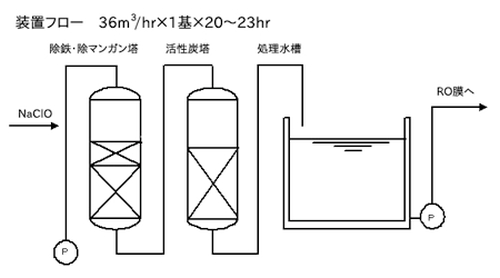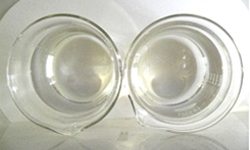Tech & Tools
Technical information
- HOME
- Tech & Tools
- Free residual chlorine removal delivery example
Free residual chlorine removal delivery example
Here are some examples of residual chlorine removal using our filter media.
At this site, in order to use the groundwater in Osaka Prefecture as water supply, iron and manganese that have exceeded the tap water quality standards are treated. Looking at the entire water purification facility, at this site, iron and manganese are removed by the iron removal and manganese removal tower, and then the treated water is filtered by the RO membrane. The RO membrane installed at this site aims to reduce the evaporation residue contained in the raw water.
However, since general RO membranes are vulnerable to residual chlorine, it is necessary to remove the residual chlorine in advance. Generally, residual chlorine is removed in advance by injecting a reducing agent such as sodium thiosulfate or filtering with activated carbon. At this site, residual chlorine is decomposed and removed with activated carbon after the iron and manganese removal towers are treated.
Raw water quality
| item | unit | Raw water | Iron removal Manganese tower treated water | Tap water standard |
|---|---|---|---|---|
| Water species | – | Groundwater | – | – |
| place | – | Osaka prefecture | – | – |
| pH | – | 7.3 | 7.3 | 5.8~8.6 |
| iron | mg/L | 0.55 | Less than 0.1 | 0.3 or less |
| manganese | mg/L | 0.25 | Less than 0.02 | 0.05 or less |
| Turbidity | degree | 0.3 | 0.1 | 2 or less |
| Saturation | degree | 4 | 2 | 5以下 |
| Free residual chlorine | mg/L | 0 | 0.8 | none |
| Evaporation residue | mg/L | 600 | 605 | 500 or less |
Iron and manganese contained in the raw water are removed by filtering with the iron removal and manganese removal tower, but since sodium hypochlorite was injected to remove these, free residual chlorine was 0.8 in the treated water. mg / L was seen. This residual chlorine is removed with activated carbon. When removing residual chlorine, the surface of activated carbon is easily oxidized and becomes brittle, so in general, strong coconut shell activated carbon is often used.

Generally, the filtration rate for removing residual chlorine with activated carbon is SV20h-1-1 or less.
The mechanism of removal of residual chlorine by activated carbon is a reaction in which residual chlorine uses activated carbon as a catalyst to decompose hypochlorite ions and hypochlorous acid. Therefore, if the residual chlorine in the raw water is too high or the filtration rate is too fast, the reaction will not proceed sufficiently and free residual chlorine may flow out into the treated water.
In addition, if residual chlorine exceeding 2 mg / L is removed, the residual chlorine significantly oxidizes the activated carbon, weakening the strength of the activated carbon and causing the crushed activated carbon powder to flow out into the treated water. Therefore, when residual chlorine exceeding 1 mg / L is removed, a phenomenon called “ashing” occurs, and an incinerated substance is generated on the surface, making it impossible to remove the residual chlorine, or a phenomenon of discharging adsorbed components occurs. I will. The concentration of residual chlorine at the entrance of the activated carbon tower must be well controlled.
| item | Activated carbon tower |
|---|---|
| Filter | φ2300mm×SH2440mm |
| Filtration material filling amount (per tower) | Activated carbon (TA-30N): 1400mm |
| Filtration rate | LV8.7m/h |
| Backwash process | Backwash: LV 25m / h x 10min Stand still: 3 minutes Filtered drainage: LVm / h x 10min |
| Backwash frequency | Once a day |
As a result of delivering the activated carbon tower as described above, we were able to completely remove residual chlorine as shown in the table below and in the photo.

| item | unit | Filtration tower entrance | Filtration tower outlet |
|---|---|---|---|
| pH | – | 7.2 | 7.5 |
| Free residual chlorine | mg/L | 0.8 | 0 |
Head Office
1-12-11 Tagawakita, Yodogawa-ku,Osaka
532-0021
Overseas Business Department
TEL +81-6-6301-6460
FAX +81-6-6308-3022




